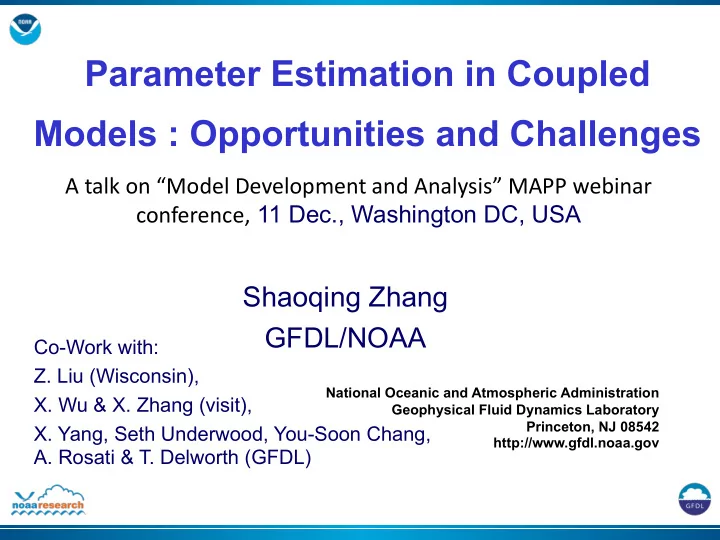

Parameter Estimation in Coupled Models : Opportunities and Challenges A ¡talk ¡on ¡“Model ¡Development ¡and ¡Analysis” ¡MAPP ¡webinar ¡ conference, 11 Dec., Washington DC, USA Shaoqing Zhang GFDL/NOAA Co-Work with: Z. Liu (Wisconsin), National Oceanic and Atmospheric Administration X. Wu & X. Zhang (visit), Geophysical Fluid Dynamics Laboratory Princeton, NJ 08542 X. Yang, Seth Underwood, You-Soon Chang, http://www.gfdl.noaa.gov A. Rosati & T. Delworth (GFDL)
OUTLINE 1. Model bias analysis: parameter errors and climate drift in coupled models 2. The importance of sufficiently observation-constrained model states for coupled model parameter estimation – demonstrated in a simple model 3. The importance of allowing model parameters to geographically vary for coupled model parameter estimation – results from an intermediate coupled model 4. Preliminary results from the GFDL CM2.1 model — Sensitivity studies & twin experiments 5. Summary, discussions and future directions
1. Model bias analysis (1): Model drift in decadal prediction with the GFDL’s ECDA system AMOC Index 22 85JAN 95JAN Color: forecasts Black: analysis 20 18 16 90JAN 14 80JAN 00JAN 75JAN 12 (Y.-S. Chang et al. 2012)
1. Model bias analysis (2): parameter errors and model bias A numerical model is a discretized version of a set of budget equations for moment, heat, moisture, salt and other tracers including physics: Three possible sources make a numerical model biased:
2. The importance of observation-constrained model states (1) : Parameter Estimation Theory Ignore the model bias caused by dynamical core and physical scheme: Expand model control variables to include model ∂ x t / ∂ t = f ( x t , β ,t) + G ( x t, , β , t) w t parameters β : Expand Bayes’ rule to include the contributions of parameter errors for model uncertainties: p ( x t , β t | Y t )= p [ y t |( x t, β t-1 )] p [( x t, β t-1 )| Y t-1 ]/ p ( y t | Y t-1 ) A linear regression ∆ β t =Cov[ β t-1 , y(x t )]/ σ m 2 * ∆ y o to implement the estimation of p ( x t , β t | Y t ). Determinated by x t , Cov[ β t-1 , y(x t )] projects ∆ y o onto β .
2. The importance of observation-constrained model states (2) : Delay parameter estimation until equilibrium of state estimation
2. The importance of observation-constrained model states (3): Comparison on a simple PE case Identical twin experiment: Simple coupled model By x2-w interaction: Using x 1 obs to estimate κ Assimilation model Obs are produced by ensemble starts with κ=29 + η (0,1) κ=28
4. The importance of allowing model parameters to geographically vary for coupled model parameter estimation (Geographic Dependent Parameter Optimization, GPO) A summary from 2 papers: 1. Wu, X., S. Zhang, Z. Liu, A. Rosati, T. Delworth, and Y. Liu, 2012: Impact of geographic dependent parameter optimization on climate estimation and prediction: simulation with an intermediate coupled model. Mon. Wea. Rev. doi: 10.1175/MWR-D-11-00298.1 2. Wu, X., S. Zhang, Z. Liu, A. Rosati, T. Delworth, 2012: A study of impact of the geographic dependence of observing system on parameter estimation with an intermediate coupled model. Clim Dyn. Doi:10.1007/s00382-012-1385-1
4.GPO (1): An intermediate coupled model(1) – Eqs. Atmosphere Streamfunction ψ : COUPLING ( λ ,C l ) Land Temperature T l : Ocean COUPLING Streamfunction φ : ( λ ,C o, ) Temperature T o : Here L 0 represents oceanic deformation radius, computed from L 0 2 =g ΄ h 0 /f 2 and s( τ ,t) represents solar forcings, others follow conventional notation.
4.GPO (2): Simple case – Time series of SST global mean RMSEs SST obs optimize K T All parameters (totally 10) are biased (10% more than truth values) in the CTL run (51 yrs). K T is perturbed in the model ensemble. State estimation only (SEO) is performed in all model components (4/day for Atm, daily for Ocn) for 51 years. SST RMSE time mean distributions Single-valued parameter 1.2 o C 31 o C estimation (SPE) of K T using SEO CTL SST obs is performed after 1- year SEO (for 50 yrs). Geographic-dependent parameter optimization (GPO) 0.4 o C 0.2 o C of K T is performed after 1-year GPO SPE SEO (for 50 yrs). Parameter ensemble is subject to an inflation scheme.
4.GPO (4): Impact of Geographic-dependent Observing System(2) – Experiment with no-data region (SST obs ->K T ) No-data region Time mean SST RMSEs Single-valued CTL SEO Parameter Estimation (SPE) reduces the maximum error by 87% from SEO (from 28 to 3.6). GPO SPE Geographic- dependent Parameter Optimization reduces the maximum error by 94% from SPE (from 3.6 to 0.23).
5.GFDL’s CM2 PE twin experiment(1): GPO-optimized α – the air-sea transfer coefficient ( Beljaars 1994) signal Signal-to-noise ratio of optimized α : [1- ( α - α truth )/ α guess ] noise strong The sensitivities of SST w.r.t. α weak
5.GFDL’s CM2 PE twin experiment(2): Impact of GPO on oceanic analysis quality: RMSE Salt:0-500 Temp:0-500 ECDA SPE Salt:500-1k Temp:500-1k GPO
6. Summary and future work The model drift in decadal climate predictions can be relaxed by optimizing coupled model parameters using observations. Enhancing the signal-to-noise ratio of state-parameter covariances & eliminating the noises in the observing system is the key for successful coupled model parameter estimation, implemented by the scheme of data assimilation with enhancive parameter correction (DA EPC ) and Geographic-dependent Parameter Optimization (GPO). The ensemble coupled data assimilation with parameter estimation (ECDA PE ) has been implemented in the GFDL CM2 (1 o x1 o Ocn +2 o x2 o Atm) to develop a new generation of climate estimation and prediction system. Here twin experiments show promising results. Further examination is required to understand the impacts of GPO on climate analysis and predictions. Further studies are required for coupling parameter-estimation using a medium observations to optimize other media model parameters.
Recommend
More recommend